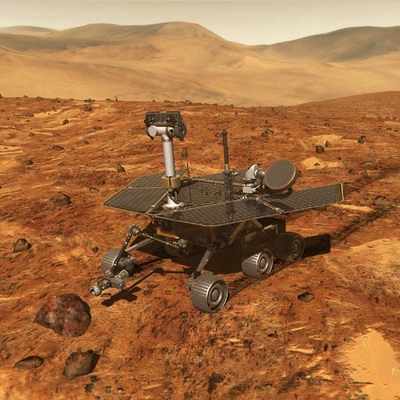But Spirit May Be In Trouble
 NASA's Spirit and Opportunity have
been exploring Mars about three times as long as originally
scheduled. The more they look, the more evidence of past liquid
water on Mars these robots discover. Team members reported the new
findings at a news briefing today.
NASA's Spirit and Opportunity have
been exploring Mars about three times as long as originally
scheduled. The more they look, the more evidence of past liquid
water on Mars these robots discover. Team members reported the new
findings at a news briefing today.
About six months ago, Opportunity established that its
exploration area was wet a long time ago. The area was wet before
it dried and eroded into a wide plain. The team's new findings
suggest some rocks there may have gotten wet a second time, after
an impact excavated a stadium-sized crater.
Evidence of this exciting possibility has been identified in a
flat rock dubbed "Escher" and in some neighboring rocks near the
bottom of the crater. These plate-like rocks bear networks of
cracks dividing the surface into patterns of polygons, somewhat
similar in appearance to cracked mud after the water has dried up
here on Earth.
Alternative histories, such as fracturing by the force of the
crater-causing impact, or the final desiccation of the original wet
environment that formed the rocks, might also explain the polygonal
cracks. Rover scientists hope a lumpy boulder nicknamed "Wopmay,"
Opportunity's next target for inspection, may help narrow the list
of possible explanations.
"When we saw these polygonal crack patterns, right away we
thought of a secondary water event significantly later than the
episode that created the rocks," said Dr. John Grotzinger. He is a
rover-team geologist from the Massachusetts Institute of Technology
in Cambridge (MA). Finding geological evidence about watery periods
in Mars' past is the rover project's main goal, because such
persistently wet environments may have been hospitable to life.
"Did these cracks form after the crater was created? We don't
really know yet," Grotzinger said.

If they did, one possible source of moisture could be
accumulations of frost partially melting during climate changes, as
Mars wobbled on its axis of rotation, in cycles of tens of
thousands of years. According to Grotzinger, another possibility
could be the melting of underground ice or release of underground
water in large enough quantity to pool a little lake within the
crater.
One type of evidence Wopmay could add to the case for wet
conditions after the crater formed would be a crust of
water-soluble minerals. After examining that rock, the rover team's
plans for Opportunity are to get a close look at a tall stack of
layers nicknamed "Burns Cliff" from the base of the cliff. The
rover will then climb out of the crater and head south to the
spacecraft's original heat shield and nearby rugged terrain, where
deeper rock layers may be exposed.

Halfway around Mars, Spirit is climbing higher into the
"Columbia Hills." Spirit drove more than three kilometers
(approximately two miles) across a plain to reach them. After
finding bedrock that had been extensively altered by water,
scientists used the rover to look for relatively unchanged rock as
a comparison for understanding the area's full range of
environmental changes. Instead, even the freshest-looking rocks
examined by Spirit in the Columbia Hills have shown signs of
pervasive water alteration.
"We haven't seen a single unaltered volcanic rock, since we
crossed the boundary from the plains into the hills, and I'm
beginning to suspect we never will," said Dr. Steve Squyres of
Cornell University, Ithaca, N.Y., principal investigator for the
science payload on both rovers. "All the rocks in the hills have
been altered significantly by water. We're having a wonderful time
trying to work out exactly what happened here."
More clues to deciphering the environmental history of the hills
could lie in layered rock outcrops farther upslope, Spirit's next
targets. "Just as we worked our way deeper into the Endurance
crater with Opportunity, we'll work our way higher and higher into
the hills with Spirit, looking at layered rocks and constructing a
plausible geologic history," Squyres said.
Jim Erickson, rover project manager at JPL, said, "Both Spirit
and Opportunity have only minor problems, and there is really no
way of knowing how much longer they will keep operating. However we
are optimistic about their conditions, and we have just been given
a new lease on life for them, a six-month extended mission that
began Oct. 1. The solar power situation is better than expected,
but these machines are already well past their design life. While
they're healthy, we'll keep them working as hard as possible."
Spirit: Waylaid?
Engineers on NASA's Mars Exploration Rover team are
investigating possible causes and remedies for a problem affecting
the steering on Spirit.
The relay for steering actuators on Spirit's right-front and
left-rear wheels did not operate as commanded on Oct. 1. Each of
the front and rear wheels on the rover has a steering actuator, or
motor, that adjusts the direction in which the wheels are headed
independently from the motor that makes the wheels roll. When the
actuators are not in use, electric relays are closed and the motor
acts as a brake to prevent unintended changes in direction.

Engineers received results Sunday from a first set of diagnostic
tests on the relay. "We are interpreting the data and planning
additional tests," said Rick Welch, rover mission manager at JPL.
"We hope to determine the best work-around if the problem does
persist."
Spirit Opportunity successfully completed their three-month
primary missions in April and five-month mission extensions in
September. They began second extensions of their missions on Oct.
1. Spirit has driven more than 3.6 kilometers (2.2 miles), six
times the distance set as a goal for mission success. It is
climbing into uplands called the "Columbia Hills."
JPL's Jim Erickson, rover project manager, said, "If we do not
identify other remedies, the brakes could be released by a command
to blow the fuse controlling the relay, though that would make
those two brakes unavailable for the rest of the mission." Without
the steering-actuator brakes, small bumps or dips that a wheel hits
during a drive might twist the wheel away from the intended drive
direction.

"If we do need to disable the brakes, errors in drive direction
could increase. However, the errors might be minimized by
continuing to use the brakes on the left-front and right-rear
wheels, by driving in smaller segments, and by adding a software
patch to reset the direction periodically during a drive," Erickson
said. Engineers believe the steering-brake issue is not related to
excessive friction detected during the summer in the drive motor
for Spirit's right-front wheel, because the steering actuator is a
different motor.
Meanwhile, the team continues to use Spirit's robotic arm and
camera mast to study rocks and soils around the rover, without
moving the vehicle until the cause of the anomaly is understood and
corrective measures can be implemented.
 ANN's Daily Aero-Linx (04.13.24)
ANN's Daily Aero-Linx (04.13.24) ANN's Daily Aero-Term (04.13.24): Beyond Visual Line Of Sight (BVLOS)
ANN's Daily Aero-Term (04.13.24): Beyond Visual Line Of Sight (BVLOS) Airborne 04.09.24: SnF24!, Piper-DeltaHawk!, Fisher Update, Junkers
Airborne 04.09.24: SnF24!, Piper-DeltaHawk!, Fisher Update, Junkers Aero-News: Quote of the Day (04.14.24)
Aero-News: Quote of the Day (04.14.24) ANN's Daily Aero-Term (04.14.24): Maximum Authorized Altitude
ANN's Daily Aero-Term (04.14.24): Maximum Authorized Altitude







